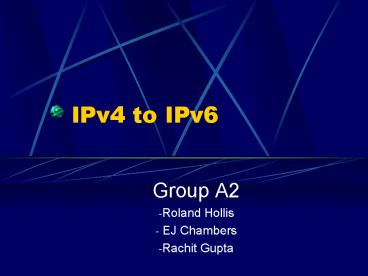IPv4 to IPv6 - PowerPoint PPT Presentation
1 / 18
Title:
IPv4 to IPv6
Description:
Aspects of IP Version 4. What about Version 5? Aspects of IP Version 6 ... spawned the concepts of Subnetting, CIDR and subnet 10. IPv4 ... subnetting work ... – PowerPoint PPT presentation
Number of Views:180
Avg rating:3.0/5.0
Title: IPv4 to IPv6
1
IPv4 to IPv6
- Group A2
- Roland Hollis
- EJ Chambers
- Rachit Gupta
2
Outline
- Aspects of IP Version 4
- What about Version 5?
- Aspects of IP Version 6
- Features of IPv6
- Auto-Configuration
- Qos
- IP Security
3
IPv4 Header
Vers
HLEN
Service Type
Total Length
VERS
Flags
Fragment Offset
Identification
Time to Live
Protocol
Header Checksum
Source IP address
Destination IP address
IP Options (may be null)
Padding
IP Datagram Data (up to 65535 bytes)
4
IPv4 Addressing
- 232 Unique IP Addresses
- This equates to be roughly 4 billion IP Address
- This should be enough, but because of network
classes, many IP address are left unused - This spawned the concepts of Subnetting, CIDR and
subnet 10
5
IPv4 Addressing
- CIDR Classless Inter Domain Routing
- CIDR and subnetting work together.
- Allow collapsing of contiguous class C networks
into a single routing table - Subnet 10
- Leaves the topology of your network up to
administrator. - Gateways and Proxies are the intermediary between
the internet and your network
6
Other Methods
- Other Methods include NATs Network Address
Translation - Acts as a buffer between global internet and your
subnet. - IP masquerading is a commonly used technique for
Linux - A modern NAT gateway must change the Source
address on every outgoing packet to be its single
public address
7
IPv5 (?)
- Why are we skipping from v4 to v6?
- IPv5 never existed!
- The version number 5 was assigned to identify
packets that carried experimental non-IP
real-time stream protocol called SP - It was abandoned for RSVP
8
IPv6 Header
Vers
Class
Flow Table
VERS
Payload Length
Next header
Hop Limits
Source Address 128 bits (4 x 32 bits)
Destination Address 128 bits (4 x 32 bits)
9
IPv6 Addressing
- 2128 IP Address
- 340 Undecillion IP Addresses
- So everyone including your cat and dog has one
- Allows true end to end communication
- A.k.a. No need for proxies and NAT
- Multicasting is required, unlike in IPv4
10
Features of IPv6
- Has a fixed header size, which then has a fixed
packet size - Checksum value was removed since they are
provided in data link and transport layers
11
NAT
- Breaks end to end communication
- Routers monitor and change the data
- Breaks Bi-directional communication
- Hosts with global address cannot initiate
communication
12
IPv6 Address
- FP Format Prefix
- Denotes addressing format used
- TLA Top Level Aggregation
- Indications country or large carrier
- R Reserved for future use
- Some instances is combined with NLA
13
IPv6 Address Cont
- NLA Next Level Aggregation
- Identifies a company or internet provider
- SLA Site Level Aggregation
- Assigned by superior identity
- Interface Id
- 64 bit IEEE EUI-64 address of hardware
- Ie the MAC
14
Auto configuration
- Neighbor Discovery Protocol
- Dynamically determines information about directly
attached networks - Replaces IPv4 ARP
- Multicast vs. ARPs broadcast
- Plug and Play
- Stateful and Stateless auto configuration
15
Quality of Service
- Different type of traffic be treated differently
by intervention router in Internet. - IPv6 has Flow Label Sender can request
request special handling. - IPv6 header has an 8-bit traffic class field.
16
IP Security (IPSec)
- A set of security services can be provided
through use of traffic security protocol - The Authentication Header(AH)
- The Encapsulation Security Payload(ESP)
17
References
- The Internet Protocol Version 6
- David C. Lee and Daniel L. Lough
- The Next Generation of the Internet Aspects of
the Internet Protocol Version 6 - Daniel C. Lee, Daniel L. Lough, Scott Midkiff,
Nathaniel J. Davis, Phillip E. Benchoff - IPv6 Future Approval Networking
- Hui Huang, Jian Ma
18
Questions?
- Comments?































